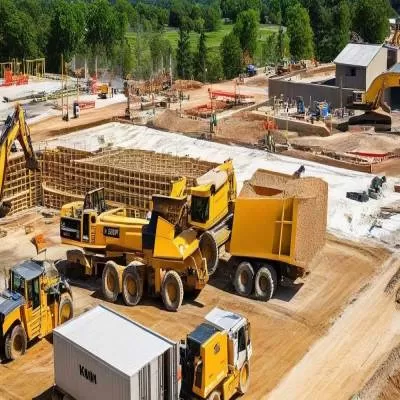Jens Mose and John Terembula, Product Line Management, FLSmidth A/S, discuss why Vertical Roller Mills (VRM) are the best grinding solution for SCMs, in this second part of a three-part series looking at how Supplementary Cementitious Materials (SCM) can help cement manufacturers reduce carbon emissions.
Current examples of SCM adoption
India is a successful adopter of SCMs, with an average clinker factor of 0.71 in 2017. This is largely thanks to the introduction of standards for composite cements in 2015, as well as the widespread availability of fly ash from thermal power plants. Portland Pozzolanic Cement (PPC) had approximately 65 per cent market share in 2017, and the clinker factor of PPC was also improved from 0.68 in 2010 to 0.65 in 2017. Portland Slag Cement (PSC) makes up about 10 per cent of the market and also reduced clinker content in that time from 0.55 to 0.40. Meanwhile, ACC has achieved a clinker factor as low as 44 per cent through the use of fly ash from power plants and slag from steel production.
In the sub-continental India region, FLSmidth has supplied grinding systems with all types of mills. The most common grinding systems installed over the last 10 years are VRM or HRP with ball mill in semi-finish arrangement. One example is the Guinness World Record holder, the largest VRM for cement grinding at Shah Cement in Bangladesh. That mill regularly produces both PPC and PSC Cements.
Throughout Asia, a wide range of blended cements are made encompassing many different additive materials including trass, which is very hard-to-grind overburden from the quarry. Stable/reliable operation has been proven in the OK Mill even with this difficult material.
In other parts of the world, the uptake of SCMs varies. For example, in Brazil the nationwide average clinker-to-cement ratio is below 70 per cent , with blast furnace slag from steel mills the most widely used SCM . The country is targeting reductions in clinker content to 59 per cent in 2030 and 52 per cent in 2050 and will need to increase the use of limestone filler and calcined clays to meet these targets.
In Brazil, the VRM has been the standard for new cement grinding for the last 10+ years, with OK Mills accounting for 28 per cent of the country’s total cement production in 2015.
Meanwhile, in the US, the use of SCMs by cement manufacturers is on the rise , as more cement plants adopt ASTM C595 Standard (American Society for Testing and Materials), which allows up to 15 per cent limestone within Type 1L or Portland Limestone Cement (PLC). PLC is currently seeing a dramatic upward trend, thanks to widespread acceptance by end users like the Department of Transportation and the Federal Aviation Administration.
Which mills are best for SCMs?
The grinding operation is critical to the success of SCMs, to achieve the necessary particle size distribution. Some materials can be ground together with the rest of your cement mix (so-called ‘intergrinding’), while others may benefit from a separate grinding operation. Likewise, water demand (to increase workability) can present another sustainability concern.
In terms of the best mill type, the answer is almost always VRM. Over the last few decades, the industry has been gradually moving towards the use of VRM for both raw and cement grinding, due largely to the reduced energy consumption compared to ball mills: a saving of between 30 and 50 per cent. This transition will prove crucial as the adoption of SCMs increases, from a practical as well as economic and environmental perspective. VRM provides much greater flexibility to grind several different materials, to switch between different cement mixes, and to adjust to changing material characteristics – all while protecting quality.
For example, FLSmidth has a customer using the OK Mill to grind 100 per cent slag with raw feed containing more than 20 per cent moisture to produce moisture levels less than 1 per cent. This is only possible thanks to the drying capacity of the VRM. This level of flexibility is imperative to SCM adoption.
Ultimately, product quality is defined by cement strength development and setting times. To achieve the best result, you need optimal particle size distribution and dehydration of the gypsum within the cement. And for that, the precise operational controls of the VRM are a clear advantage over other mill types, enabling you to optimise the system’s temperature profile, mill airflow, separator speed and grinding pressure for optimum efficiency and productivity.
1- https://docs.wbcsd.org/2018/11/WBCSD_CSI_India_Review.pdf
2- Weston, J. ‘Brazil gives OK to VRM’, International Cement Review, 20 June 2016
3-https://www.mckinsey.com/~/media/mckinsey/dotcom/client_service/infrastructure/pdfs/pathways_low_carbon_economy_brazil.ashx
4- http://snic.org.br/assets/pdf/roadmap/roadmap-tecnologico-do-cimento-brasil.pdf
5- https://pubs.usgs.gov/of/2005/1152/2005-1152.pdf p.10
You can find part one in the August issue of Indian Cement Review and part 3 in the upcoming October issue.
(Communication by the management of the company)


 Concrete1 month ago
Concrete1 month ago
 Concrete1 week ago
Concrete1 week ago
 Concrete4 weeks ago
Concrete4 weeks ago
 Concrete1 month ago
Concrete1 month ago





















